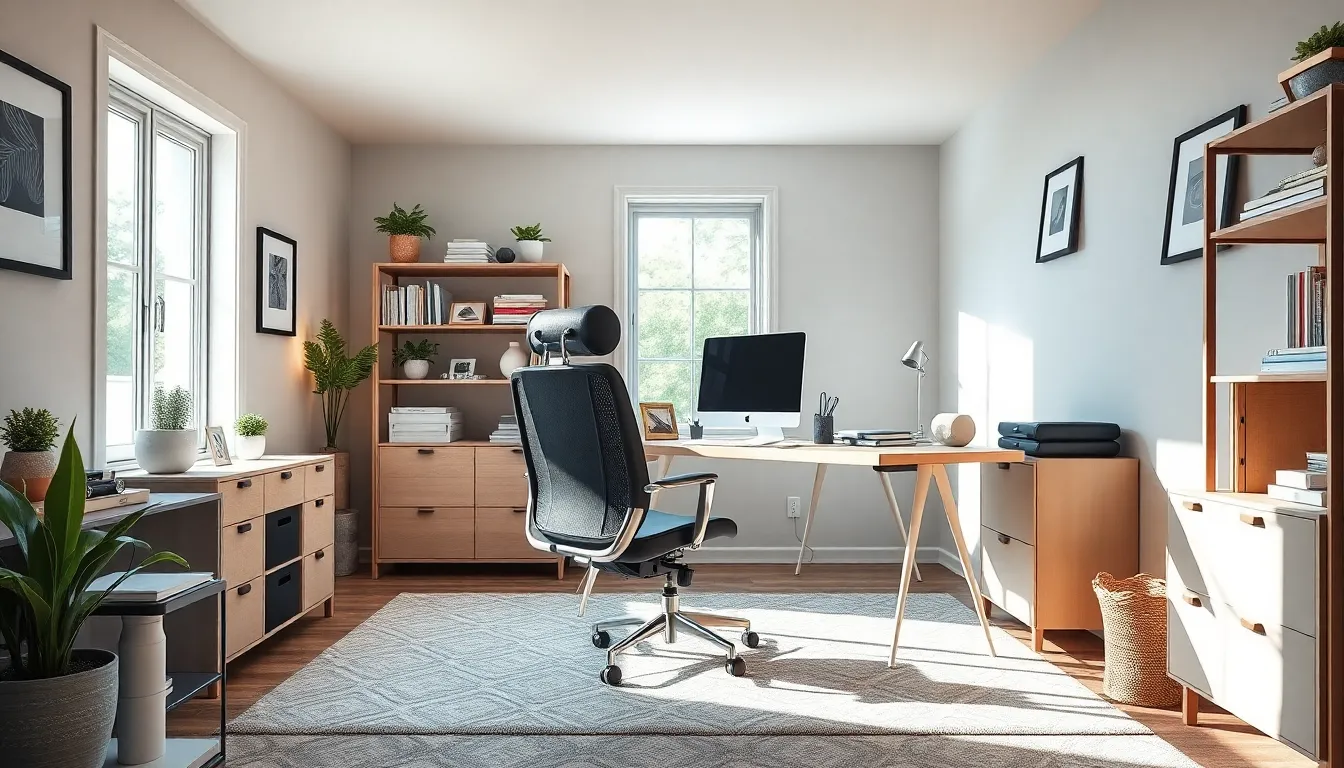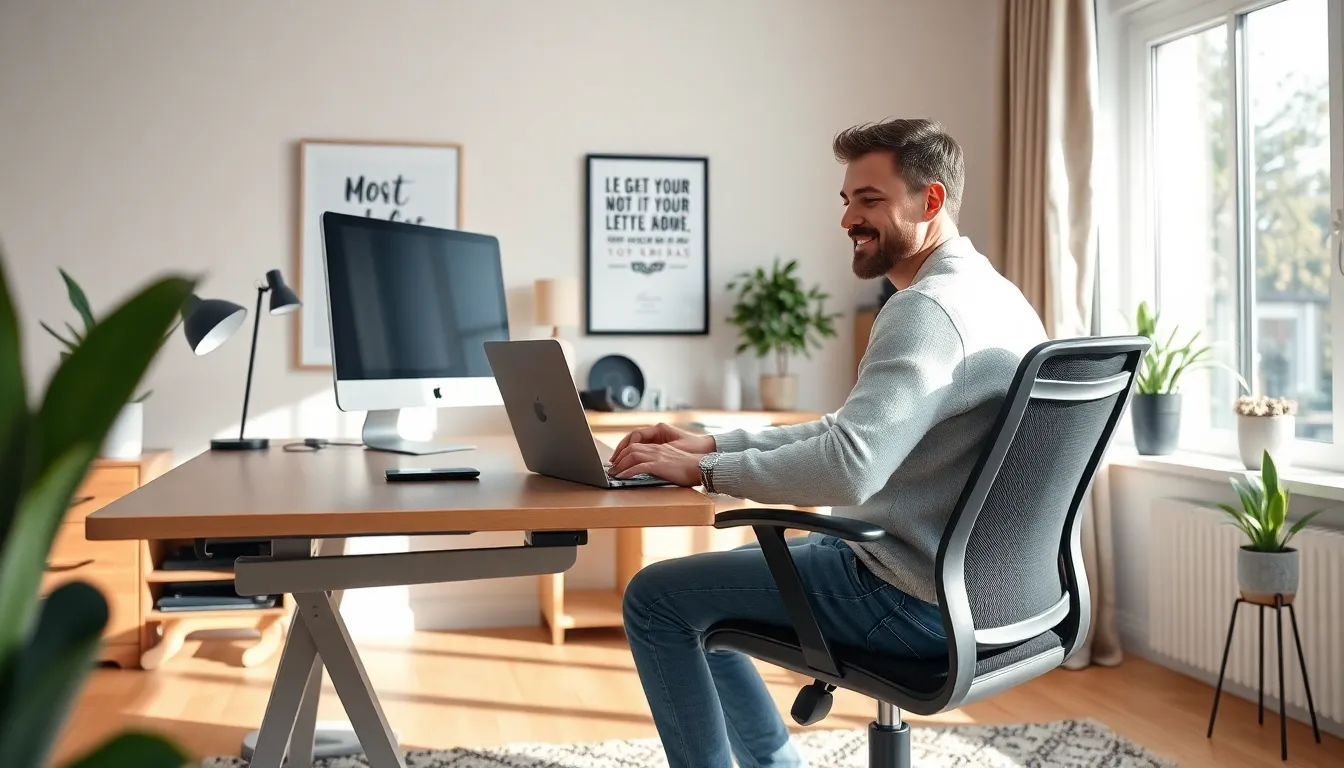In today’s fast-paced world, creating an efficient home office has become more important than ever. As remote work continues to rise, individuals seek to transform their spaces into productive environments that inspire creativity and focus. A well-designed home office can significantly enhance productivity while providing a comfortable and personalized atmosphere.
From choosing the right furniture to optimizing lighting, every detail plays a crucial role in crafting the ideal workspace. By understanding the principles of home office design, anyone can create a sanctuary that not only meets their professional needs but also reflects their personal style. Embracing thoughtful design can lead to a more enjoyable work experience and a better work-life balance.
Table of Contents
ToggleImportance Of Home Office Design
Home office design significantly impacts productivity and overall well-being. A thoughtfully arranged workspace enhances focus and efficiency. It fosters creativity by stimulating a positive mindset, essential for effective work.
Comfortable furniture plays a vital role in extending work hours without fatigue. Ergonomic chairs and desks support posture, reducing strain during long periods. Strategic lighting contributes to an energized environment. Natural light boosts mood, while appropriate task lighting minimizes eye strain.
Organization systems like shelving and filing cabinets maintain a clutter-free space. A tidy environment reduces distractions, allowing for better concentration. Personal touches, such as art or plants, make the workspace inviting and reflective of individual style.
Incorporating technology through effective cable management optimizes space usage. Well-placed electrical outlets and charging stations facilitate seamless work processes. Comfort and aesthetics combined create a harmonious balance between work and personal life. High-quality home office design ultimately leads to enhanced productivity and a better work-life balance.
Key Elements Of Home Office Design

Effective home office design emphasizes several key elements that contribute to maximizing efficiency and comfort. Understanding layout, furniture, and lighting plays a crucial role in creating a productive work environment.
Layout Considerations
Arranging a home office layout effectively enhances workflow.
- Work Zones: Establish specific areas for different tasks, such as a dedicated space for computer work and another for meetings or creative projects.
- Traffic Flow: Ensure easy movement between areas to minimize disruptions.
- Proximity to Resources: Place frequently used items like printers or filing cabinets within easy reach to enhance productivity.
- Accessibility: Position key components, such as desks and shelves, in a manner that allows easy access while maintaining stability in the workspace.
Furniture Choices
Selecting the right furniture promotes comfort and efficiency.
- Ergonomic Chairs: Invest in chairs that support posture, reducing strain during long hours of work.
- Desks: Choose desks with adequate surface area to accommodate essential equipment, such as computers and monitors, while allowing space for writing or reading.
- Storage Solutions: Incorporate shelves, drawers, or cabinets to keep essential items organized and easily accessible.
- Personalization: Use furniture that reflects individual style, creating an inviting atmosphere that enhances motivation.
Lighting Options
Proper lighting impacts mood and productivity significantly.
- Natural Light: Maximize the use of windows to bring in daylight, enhancing energy and focus.
- Task Lighting: Utilize desk lamps or adjustable lighting fixtures for direct illumination during critical tasks, minimizing eye strain.
- Ambiance: Incorporate softer lighting options for relaxation during breaks, creating a balanced environment.
- Layered Lighting: Combine various light sources, such as overhead, task, and accent lights, to achieve an adaptable and functional workspace.
Tips For Designing An Effective Home Office
Creating an effective home office involves strategic planning and thoughtful design choices. Focusing on space optimization and personalization enhances both functionality and comfort.
Maximizing Space
Maximizing space facilitates better functionality in a home office. Prioritize the following strategies:
- Use multi-functional furniture: Select desks with built-in storage or adjustable height options to save space and accommodate various tasks.
- Incorporate vertical storage: Utilize wall-mounted shelves and cabinets to keep floor areas free and maintain accessibility to essentials.
- Opt for a corner layout: Consider an L-shaped desk in a corner to achieve a spacious feel while maintaining a dedicated work zone.
- Employ ergonomic designs: Choose chairs and desks that provide comfort without consuming excessive space.
Personalizing Your Workspace
Personalizing a workspace can make it more inviting and enjoyable. Consider these elements:
- Select motivational decor: Hang artwork or inspirational quotes that resonate personally to create a positive atmosphere.
- Add greenery: Incorporate indoor plants to improve air quality and enhance aesthetics, contributing to a vibrant environment.
- Customize color schemes: Choose colors that promote focus and creativity, such as soft blues or energizing yellows, to evoke the desired mindset.
- Include personal items: Display cherished items like photos or mementos that foster a sense of comfort and connection to the workspace.
Implementing these strategies in home office design leads to a productive and inspiring work environment.
Trends In Home Office Design
Home office design is evolving, reflecting modern demands for functionality and personal expression. The latest trends feature minimalist aesthetics and eco-friendly designs that enhance both productivity and environmental sustainability.
Minimalist Aesthetics
Minimalist aesthetics focus on simplicity, clarity, and functionality. This design choice promotes a clean workspace devoid of clutter, which aids concentration. Key features include:
- Neutral Color Palettes: Soft, muted tones create a calming atmosphere while promoting focus.
- Streamlined Furniture: Simple, multi-functional pieces minimize visual distractions. Furniture items like sleek desks and minimal shelving enhance organization.
- Decluttered Surfaces: Reducing items on desks fosters an uncluttered environment, making it easier to maintain concentration.
- Natural Light: Emphasizing large windows allows sunlight to fill the space, connecting the indoor area to the outdoors and enhancing overall well-being.
Eco-Friendly Designs
Eco-friendly designs prioritize sustainability, integrating natural materials and energy-efficient solutions. These elements contribute to a healthier workspace and environment. Consider these components:
- Sustainable Materials: Using reclaimed wood, bamboo, and recycled metals for furniture promotes eco-consciousness while providing durability.
- Energy-Efficient Lighting: Incorporating LED fixtures reduces energy consumption, while maximizing natural light sources improves mood and productivity.
- Indoor Plants: Integrating greenery purifies the air and enhances aesthetics, creating a more inviting atmosphere.
- Low-VOC Paints: Selecting paints with low volatile organic compounds ensures improved indoor air quality, making spaces healthier for users.
Adopting these trends not only enhances the home office experience but also aligns with broader values of sustainability and wellness.
Crafting an effective home office is essential for anyone navigating the demands of remote work. A well-designed workspace not only enhances productivity but also promotes overall well-being. By focusing on key elements like furniture selection and lighting, individuals can create a space that reflects their personal style while meeting professional needs.
Embracing current trends such as minimalist aesthetics and eco-friendly designs can further elevate the home office experience. These approaches not only foster functionality but also contribute to a healthier environment. Ultimately, investing time and thought into home office design can lead to a more enjoyable work experience and a harmonious work-life balance.








